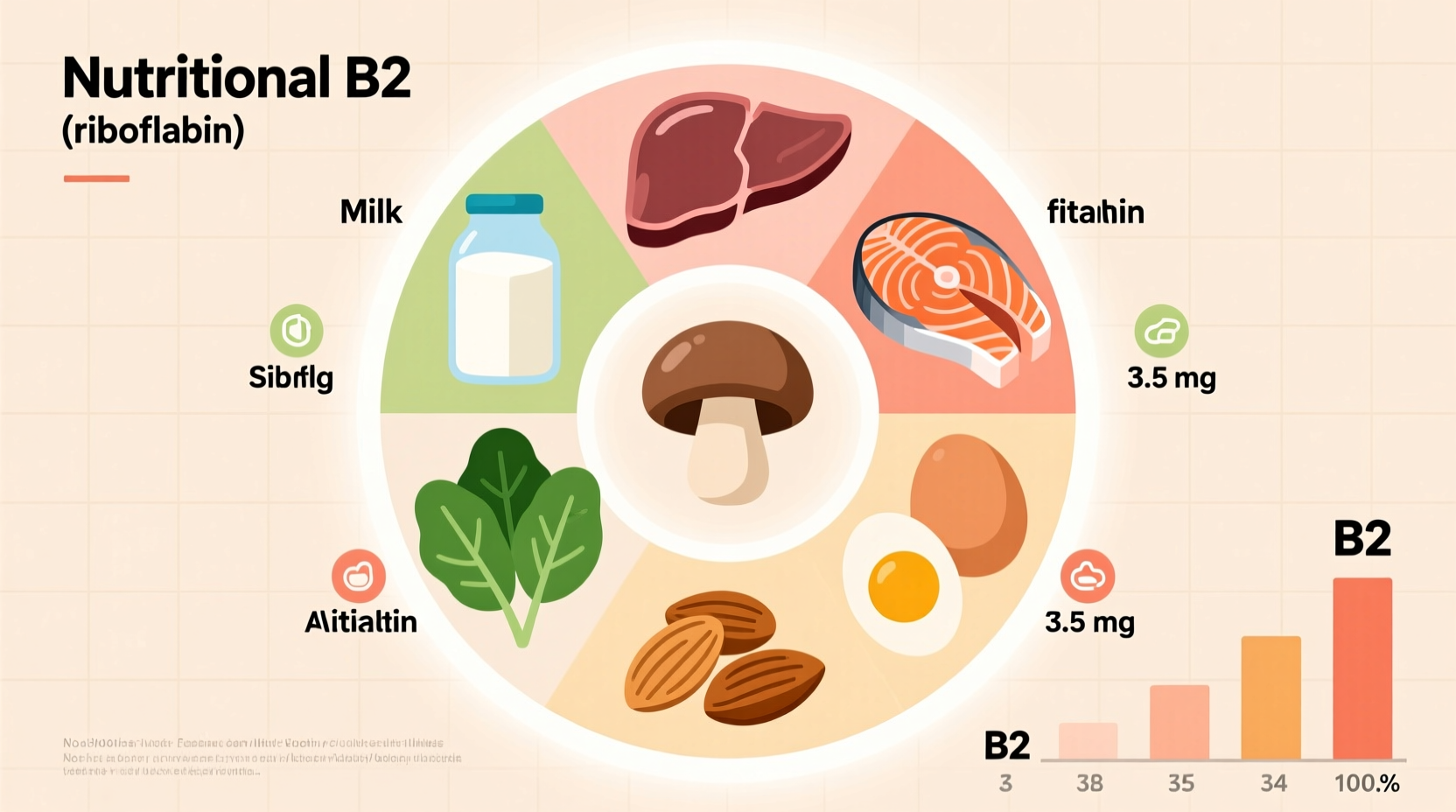The top vitamin B2 (riboflavin) foods include organ meats like liver, dairy products such as milk and yogurt, eggs, almonds, and mushrooms. Just 3 ounces of beef liver provides over 100% of your daily riboflavin needs, while a single cup of milk delivers about 25%. For plant-based options, spinach, broccoli, and fortified cereals offer substantial amounts to support your energy metabolism and cellular function.
Discover exactly which foods pack the most riboflavin punch and how to incorporate them into your daily meals. This science-backed guide reveals the complete spectrum of vitamin B2 sources—from animal products to plant-based options—with precise nutritional values and practical consumption tips you can implement immediately.
Why Vitamin B2 Matters for Your Health
Vitamin B2, also known as riboflavin, serves as a critical coenzyme in energy production and cellular function. According to the National Institutes of Health, riboflavin helps convert carbohydrates, fats, and proteins into usable energy through its role in the electron transport chain. Without adequate B2, your body struggles to maintain healthy skin, eyes, and nervous system function.
The recommended daily allowance (RDA) varies by age and gender:
- Men aged 19+: 1.3 mg
- Women aged 19+: 1.1 mg
- Pregnant women: 1.4 mg
- Lactating women: 1.6 mg
Deficiency symptoms often manifest as cracked lips, sore throat, and sensitivity to light. Athletes and pregnant women face higher riboflavin requirements due to increased metabolic demands.
Vitamin B2 Powerhouses: Food Category Breakdown
Animal-Based Vitamin B2 Sources
Animal products generally provide the most concentrated riboflavin sources. The USDA FoodData Central database confirms these top performers:
| Food | Serving Size | Vitamin B2 (mg) | % Daily Value |
|---|---|---|---|
| Beef liver | 3 ounces | 2.9 | 223% |
| Yogurt, plain | 1 cup | 0.6 | 46% |
| Milk, 1% | 1 cup | 0.34 | 26% |
| Eggs | 2 large | 0.54 | 42% |
| Salmon | 3 ounces | 0.22 | 17% |
Notice how organ meats dramatically outperform other animal products. While liver might not appeal to everyone, incorporating just 1-2 servings weekly can significantly boost your riboflavin intake.
Plant-Based Vitamin B2 Options
Vegetarians and vegans can still meet their riboflavin needs through strategic food choices. Research from the American Journal of Clinical Nutrition shows these plant foods deliver substantial amounts:
- Almonds: 1 ounce provides 0.26 mg (20% DV)
- Mushrooms: 1 cup cooked delivers 0.36 mg (28% DV)
- Spinach: 1 cup cooked contains 0.19 mg (15% DV)
- Fortified cereals: Many provide 100% DV per serving
- Quinoa: 1 cup cooked offers 0.19 mg (15% DV)
For those following plant-based diets, combining multiple sources throughout the day ensures adequate intake. A breakfast of fortified cereal with almonds, lunch featuring quinoa salad, and dinner with mushrooms creates a riboflavin-rich eating pattern.

Maximizing Vitamin B2 Absorption: Practical Strategies
Riboflavin absorption depends on several factors you can control. Unlike some vitamins, B2 remains stable during cooking but degrades when exposed to light. The Linus Pauling Institute at Oregon State University recommends these evidence-based strategies:
- Store dairy products in opaque containers - Light exposure destroys up to 50% of riboflavin in milk within 2 hours
- Pair with iron-rich foods - Riboflavin enhances iron absorption, creating a nutritional synergy
- Avoid excessive alcohol - Chronic consumption impairs riboflavin metabolism
- Cook vegetables minimally - Steaming preserves more riboflavin than boiling
For athletes seeking performance benefits, timing matters. Consuming riboflavin-rich foods within 30 minutes after exercise supports faster recovery by optimizing energy production pathways.
Special Considerations for Different Dietary Needs
Your vitamin B2 requirements change based on life circumstances. The National Academy of Medicine identifies these context boundaries:
- Vegans: Must rely on fortified foods and mushrooms as primary sources since plant options contain less bioavailable riboflavin
- Pregnant women: Need 25% more riboflavin to support fetal development, particularly neural tube formation
- Lactose-intolerant individuals: Should prioritize eggs, almonds, and leafy greens over dairy sources
- Older adults: Often require supplementation as absorption decreases with age
For those managing migraines, research published in Nutrients journal shows high-dose riboflavin (400 mg daily) may reduce frequency. However, always consult your healthcare provider before taking supplements.
Common Vitamin B2 Myths Debunked
Several misconceptions persist about riboflavin sources. Let's clarify with evidence:
- Myth: All plant milks contain significant riboflavin
Fact: Only fortified versions provide meaningful amounts - check labels carefully - Myth: Cooking destroys all vitamin B2
Fact: Riboflavin withstands heat but degrades in light - proper storage matters more than cooking method - Myth: You need supplements to meet requirements
Fact: Most people easily meet needs through diet alone unless following restrictive eating patterns
Remember that riboflavin works synergistically with other B vitamins. A balanced approach to nutrition always trumps isolated nutrient focus.
Your Vitamin B2 Action Plan
Implement these simple strategies to boost your riboflavin intake:
- Start your day with fortified cereal and almonds
- Include eggs or dairy in at least one daily meal
- Swap regular rice for quinoa in grain dishes
- Add mushrooms to omelets, stir-fries, and salads
- Store milk and yogurt in opaque containers away from light
For personalized guidance, consult a registered dietitian who can assess your specific nutritional needs. Most people achieve optimal riboflavin status through consistent inclusion of these foods without supplementation.











 浙公网安备
33010002000092号
浙公网安备
33010002000092号 浙B2-20120091-4
浙B2-20120091-4